Tempe 2009
“How in the hell do you train for this?”
I remember asking the question very clearly of a race official when I did my first Tempe Triathlon in May of 2006. I had crossed the finish line and didn’t look like I was in much shape to do so. I looked a lot closer to being embalmed than I did to being a triathlete.
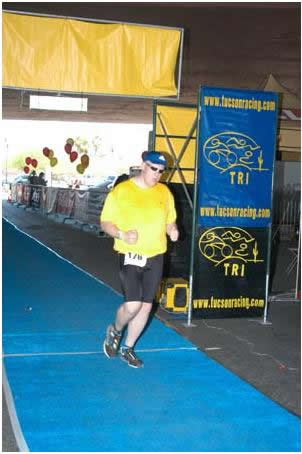
Ever since then, I’ve considered just how hot this race can get when I start training for it. The race information page points out that “Average day time temperatures in Phoenix in late May are 97-98 degrees. Due to the low humidity, nights are quite cool, dipping into the 60s. You might even need a sweatshirt at race start! The temperature at the finish should be no more than the mid-80s. Regardless of the temperature, you can expect great support on the race course.”
I don’t know if it’s my bad luck or absolute lies by the promoters, but every year that I’ve done this race the run takes place when it’s in the mid-90s. Maybe I should swim faster, but this year wasn’t any more pleasant from a temperature standpoint.
Every year I find myself in more and more interesting conversations on how to prepare. The first year I got ready a little earlier, as if it was any other race. That led to the picture you see above. The following year I trained outside with Nannette, wearing a plastic sauna suit in eighty degree weather and doing an hour-long circuit training workout. Last year my trainer Zoe had me doing wind sprints alternating with quarter-mile laps on a 90-degree afternoon. We discussed turning on the heat in my apartment and running a vaporizer in my office while I rode the bike until we figured it would short out all of the computer equipment. This year I didn’t use air conditioning in my house, ran workouts at the Pit of Despair (a retention pond near my house where the afternoon temperatures were amplified by the rocks), and did my CompuTrainer rides in the sauna suit. Ultimately my goal was to get comfortable in warmer temperatures, and in this task I think I succeeded.
In the middle of the week, though, the forecast got ugly. Heat advisories were being issued for Las Vegas, which crossed 100 for the first time on Thursday. Tempe was, on average, usually 7 degrees hotter, and the forecast for Sunday called for a high of 109.
My esteemed coworker and training partner Lisa Zelazny would be doing this race, and we watched the rising mercury with alarm. She had entered this race the year earlier and had to withdraw due to injury; we’d meet up in the mornings and go through the water temperature forecasts.
“It’s going to be hot.”
“There’s no shade at all on the run. Maybe if you stand next to a light post, but that’s about it.”
“I’m going to get some insulated water bottles or the water will be warm before I get to the bike.”
“If it stays like this they won’t allow wetsuits.”
This cheered Lisa, but I wasn’t happy with it. If the water’s cold, a wetsuit will help you stay a little warmer, but not by much. The way a triathlon wetsuit works is not by keeping you dry, but by keeping the water close to your body where it warms up and doesn’t feel as cold. So you saw the part where you get wet anyway, right? All right, let’s get to the real way a triathlon wetsuit works. The real reason a triathlon wetsuit works is its outside is smooth and it’s made of different thicknesses of neoprene rubber, which help you float, and which allow you to swim faster as the drag on the wetsuit isn’t as prominent as it would be on your skin. When the water temperature gets above 78 degrees, wetsuits are not allowed by triathlon’s governing body, USA Triathlon.
I’m in favor of swimming in wetsuits because, on average, my swim times are about five minutes faster in them and it only takes about a minute and a half more to get the thing off. (That’s right, how fast I can get undressed is timed in my sport of choice.) Lisa doesn’t like them because they make her feel claustrophobic. We’d done some work in them at Lake Mead the week earlier, and she felt a little better, but we kept watching the water temperature to see.
Tempe Town Lake didn’t even open until 1999 and isn’t really a lake as much as it is a science experiment. It’s treated water, cleaned with chemicals, aeration, and runoff. In short, it’s about the same water quality as the water hazard at your miniature golf course. In Tempe I keep Neosporin in my transition bag. Since it’s not really a lake, at its deepest point it’s only 12 feet deep, so it can heat up 4-5 degrees in a day when it gets hot. Since there’s minimal humidity in the desert, though, everything cools down after dark.
Armed with this knowledge, I packed my wetsuit anyway, just in case. Also along for the ride were my walking shoes, dress shoes for dinner, sandals for before the swim and after the race, my bicycling cleats, and my running shoes.
I would be gone for 30 hours. Triathlon is a little bit gear-intensive.
We met up for breakfast at Sunrise Café and were soon on the road to Kingman, one time hometown of executed Oklahoma City bomber Timothy McVeigh. To give you a quick idea of what this little slice of paradise is like, draw a cross. The staff of the cross is US 93. The arms of the cross are I-40. The armpit region? That’s Kingman.
Kingman is proud of its affiliation with Route 66, and their pride is evident by how they treat new visitors. There are four gas stations when you come into Kingman from the south. The first two are Chevron and Shell. Their prices match the prices you just saw in Las Vegas. The difference is, Arizona taxes gasoline differently than Nevada does, so in about 500 feet, at the other two stations, you find out that gasoline can be had for about a quarter less per gallon. For all the romantic talk about the Mother Road and its denizens, no one ever claimed they weren’t fleeced by the locals at every opportunity. (However, maybe your life has an insufficient amount of alpaca blankets and Genuine Indian jewelry and moccasins; if this is the case, by all means, go.) Every year I realize that the fifteen minutes I spend in Kingman is credited to my soul and will be applied to my balance in purgatory.
Pretty soon I was making liberal use of the cruise control, and soon I was at the hotel. The staff was far more relaxed as they’d been through their crunch already; Arizona State had held its graduation on Wednesday (they’re right across the street), and this was the last even slightly busy weekend before they closed half the place down.
We made our way over to the race expo, about the same size as prior years but in a larger space at the park. It was already 102 and athletes and families alike were dodging the sun at every opportunity. I never feel ready for this part of living in the desert, that strolling-into-a-kiln sensation that’s the norm for this region of the country from June to October. I try not to complain about it, the same way that I don’t gloat when it’s 70 in January.
We’d walked the two blocks from the Haydens Ferry Parking Garage to the race expo, rolling our bicycles. Lisa’s husband Mike was already talking about the heat; his normal shift is at night so he usually spends these parts of the day indoors. We made our way into Tempe Beach Park past an assortment of vendors. There were the usual cycle shops and supply places, mixed in with Jamba Juice and something called the Bionic Band.
“Want to try one of these, sir? It’ll make you faster!”
I smiled and shook my head no. The posters showed teams of runners and commando-type people with assault rifles wearing these items, which looked like the timing chip I’d have on my ankle tomorrow, on their wrist. The display boards promised something about electromagnetic interference. I already wear a yellow bracelet on my wrist that announces a cause; I didn’t need to wear one that stated “I’M GULLIBLE.”
We went through the tents still rolling the bicycles. For the first time this year Tempe was having the racers rack the bikes the night before, so everyone had their bicycles with him even while standing in line. In San Diego people casually leave their bicycles in an open area in the center of the expo while they walk the 25 feet to race check-in, packet pick-up, and T-shirt acquisition. Here they hung onto their rides like their ATM cards.
I asked Sara to hold my bike while I went to check out the roster to see if I could find my race number. They had the sheets taped to a rental truck, next to the course map. At the top of the sheets was an arrow pointing to the left. I had to look for a few seconds to figure out what this meant.
The forms were in alphabetical order, but the sheets were taped to the van starting in the upper right hand corner, moving to the left and down – kind of how you read the Chinese alphabet. Finding your own name became a matter of practically throwing darts. What I couldn’t understand was why, even at gunpoint, with a whole truck surface in front of you, someone decided this was the most logical way to convey information. Racers were dragging their fingers down the individual sheets, not seeing their name, then having to go up and to the left to find the next one, until they got to the leftmost sheet, go down and all the way to the right…so for want of two minutes of collating, hundreds of people stood there for an extra five minutes.
I went back to the lines with our numbers and proceeded to check-in. As a USAT member, I don’t have to sign any forms that say “No, really, this could kill you” because I’d already done so online. They attached a paper sticky bracelet with my number, 416, to my wrist. It was yellow and had pink and blue balloons reading “Party Time!” I walked over to get numbers (also yellow), my shirt (featuring yellow letters), and my swim cap for my wave (yellow as well). The color scheme certainly provided a positive level of mojo.
We racked our bikes in transition, finding a space near the outside snow fence. The race had not sold out but our assigned area was crammed pretty tight, and the amount of space in the morning would be tricky. Other people had brought their transition towels to cover their bikes; I wish I’d thought of it.
We met up with Jeff, a vendor from Motorola who Lisa works with, his wife, and his children. This was his first Olympic-distance race. I asked if he was ready to club me like a baby seal. He laughed and said I’d be waiting around for him at the end. We caught the race meeting, at which the race director cheerfully explained that once again, the run course included a large flight of stairs to get up the Mill Avenue Bridge at the 2.5 mile mark of the run course.
Jeff’s family pointed out that there was a terrific frozen yogurt store a couple of blocks from the park, closer to the ASU campus. We walked over and everybody picked some up, except me; I don’t use the day before a race as a time to try new foods. If it had been a place I’d eaten before, maybe, but Saturdays are always a day to make sure that nothing’s going to upset my stomach in the water. We arrived at Mojo Frozen Yogurt to find a place with Bauhaus furniture and fixtures, an early 70’s color scheme, and Little Rascals movies playing on plasma televisions. I love college towns.
Pretty soon we were back at the hotel. And I had time to get showered and ready for dinner, table pour une at Eddie V’s Edgewater Grill. The restaurant’s located in this cranked up shopping center called DC Ranch, filled with the sorts of places that the men playing golf at Grayhawk Golf Club across the street can send their wives; salons, design studios, furniture.
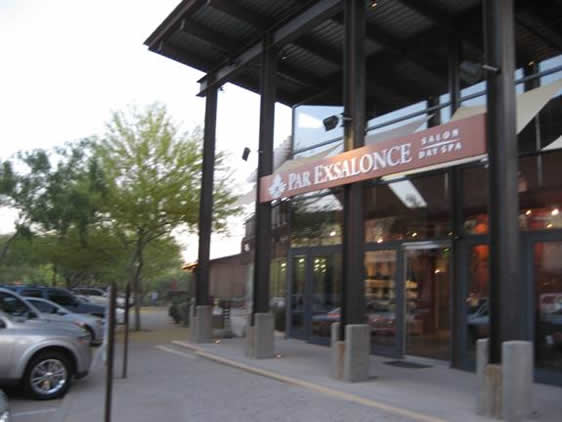
The best part about it, is, it’s very dark, always nice after spending the day in front of some near-nuclear sunshine. I had the same meal I always have; shrimp cocktail, grilled swordfish (this came with Jonah crab and avocado in vinaigrette), and some green beans with sun dried tomatoes. Beverages were a liter of San Pellegrino and lots of tap water. The staff was terrific, the food was perfect, and the only thing that was a problem was a telltale flashing red dot that would show up in various parts of the room; this signified I needed to cover my eyes at once. A flashbulb in that place would make me see spots for an hour. I avoided them all. I walked out and heard Faith Hill’s “Cry”, which used to be my former trainer Nannette’s ringtone, and I called her and left a message in Mississippi. She had done this race as a sprint when it was my fourth triathlon (the one you see pictured above) and I made sure to thank her for everything she’d done and for me still being here, sixteen races later. I walked around for a few minutes and made my way back to the hotel.
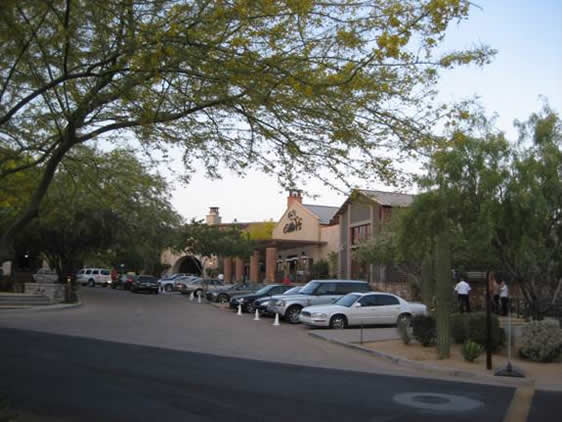
I packed everything, called for a wake-up call, set my cell phone, loaded the car, headed to the third floor ice machine and loaded the cooler, mixed the electrolyte drink, water bottles, and Gu flask, and had everything ready for morning by 9:15. The room had basic cable, and HBO, bless them, was playing “Desperado” until 10 PM. Explosions, mayhem, anger, revenge, copious amounts of blood; it’s the perfect movie for a night before a race.
I was awake early and really jumpy for some reason. I saw the clock read 4, so I knew I’d have some time to sleep, but I couldn’t. The wakeup call I was expecting never came; I looked at the clock and saw 5:06. I jumped out of bed, started the coffeepot to make cream of rice cereal for breakfast (I like getting some carbs in my stomach that are easy to digest, not heavy, and it doesn’t taste like anything, which is why I add red pepper and oregano) I was supposed to be downstairs at 5:15 to get to transition. Even though the race wouldn’t start for me until 7:09, transition would close at 6:20, and Lisa needed more time than I did to get set up. We met downstairs at about 5:20.
We wound up in the same parking garage as the day before and loaded our gear into place. They announced over the loudspeakers that the water temperature was 79 degrees, so wetsuits would not be allowed. I was grumbly but not too concerned, except for the fact I’d have to do the pre-race without a shirt. I’m heavier than most other triathletes and have too much skin, but after a while you don’t notice any more.
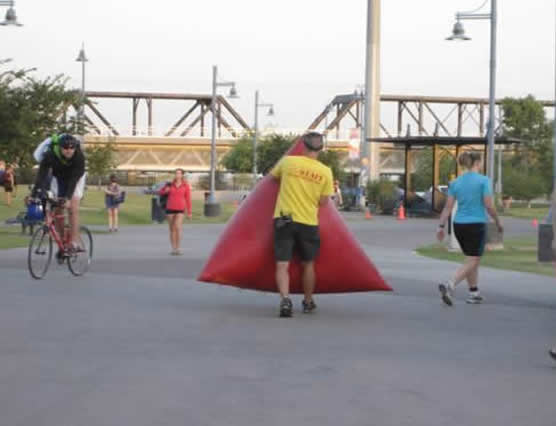
Until Lisa’s kids started taking pictures. “I have a rule; no pictures of me without a shirt on Facebook.” Everyone laughed. Not only am I one of the whitest people alive and have extra skin that will take more work to minimize, I was also wearing NipGuards, a genius product that assists me in ensuring that taking off a T-shirt doesn’t cause me to wince with pain for three days and finish races with the inside front of my shirt specked with blood. So I’m wandering around in skin-tight Lycra cycling shorts and a couple of octagon-shaped pasties the size of dimes. Do yourself a favor and skip the visual, won’t you?
Lisa looked over at me. “It’s hot already and it’s only going to get worse. Whose idea was this? I hate you.” I shrugged my shoulders and we wished each other luck.
I was starting 15 minutes earlier than Lisa, so I ate a Gu packet and got in with the rest of my wave. The overall fitness level of the Arizona race participants is far higher than almost every other race that I do. The Southwest region has a dry climate, a long season, an Ironman race, a large university across the street and another one not too far away, and it’s relatively cheap to stay here. There are bodies in Chicago that I can calmly aspire to and surpass. There are bodies on this course I could never hope to achieve. I’m an 85th percentile cyclist in Chicago. Out here I just hope I don’t finish last in my age group. These people are serious.
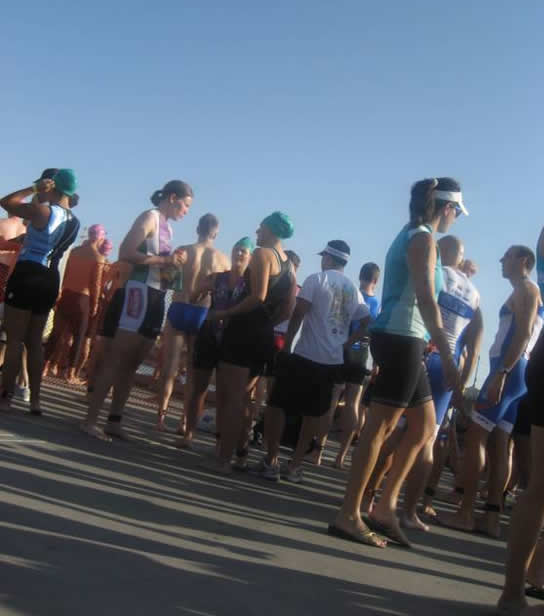
They were holding up signs that read WAVE 10 YELLOW, just like Chicago, only none of their time sheets had wave numbers next to the times. Once we got the ages coordinated everything was OK. The conversation was the usual pre-race small talk.
“Do you see any fish in there?”
“I’ve never seen any that are alive.”
“We’re headed all the way down there?”
“Do we go to the left or the right of the bridge piling?”
“Just don’t swim right into it. I’ve done that once.”
With the outside temperature already in the mid-80s with the sun barely up, the water felt cool to jump into. I moved myself towards the back of the pack; there are much faster swimmers here and it was easier to avoid contact. I was certainly eager to get out of the way of a gentleman who managed to kick me twice while we were treading water awaiting the start.
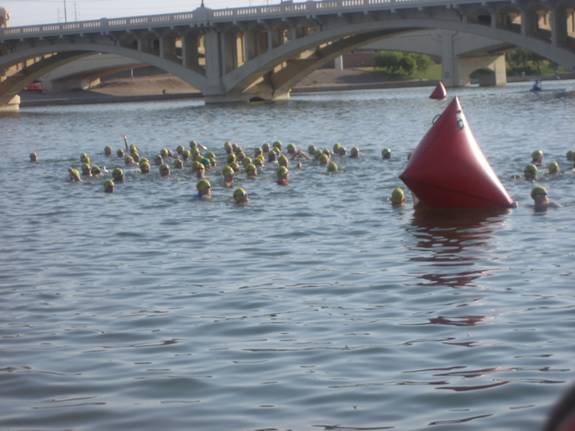
I looked straight ahead at the bridges, trying to determine a line. I stared at the swimmers in front of me, wondering who might be good to follow. We would be heading directly towards the sun, so I had on the dark-tint goggles, which had some leak issues the week before, so I made sure they were super-tight and vacuum-sealed to my face.
The race director shouted, “Twenty seconds.”
I started my watch. I thought quickly about another year, another hot day, the butterflies in my stomach and the churn that was coming.
The siren went off.
Triathlon swimming has been described as “Australian rules football in a washing machine,” and this one was no different. The first 25 yards had hip checks, getting hit in the sides and calves, and a lot of small stops and starts to establish a pace. With the position of the sun it was hard to see the large buoys directing us so I just aimed for the bridge. I finally got a decent line and was getting in rhyPOW
I was elbowed in the nose, on the right side of my face. Somebody was bringing their arm back to extend it on their freestyle stroke and my face was in the way. I saw stars for a moment, and exhaled and ran through the list. Broken? It didn’t hurt like crazy when I touched it, so I guessed no. Bleeding? I wiped it really fast and looked at my fingers. No. Bruised? It was starting to feel like it, but nothing where I couldn’t continue. I thought of Jarren, getting hit flush in the face with a soccer ball and being knocked to the ground, getting up, checking his nose, and running faster. I shook my head and jumped back into the fray.
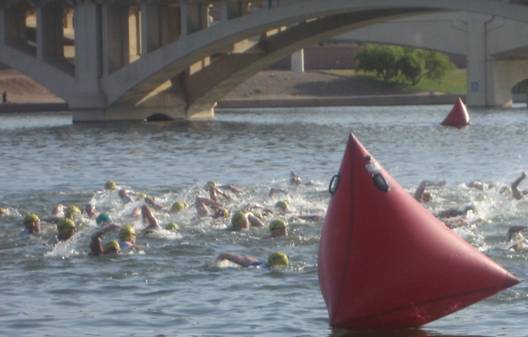
I reached the bridge very quickly, and the next buoy out was very hard to see. The sun was low enough, and directly in my face, that I had to stare into it to see where I was going. I checked for another head and decided to follow them in the short term. The count was two buoys and then a left. The goggles were a little bit leaky but that was starting to clear up; maybe my face and the plastic just got soggy enough to mesh. I had a decent line at the turnaround buoy; the elite female swimmers had taken more of the inside so I wouldn’t have to deal with another round of contact. I was making decent time even though I’ve been doing a lot more cycling and running lately. The goal for today was to survive the swim so I could get to the other stuff. I made it under both bridges, enjoying little things like how the bridge shadows made it seem like I was swimming into a pool of light. I made the turn at the last buoy and aimed towards the bleachers, where volunteers were helping people out. I climbed carefully up the steps and made my way to bike transition.
I saw Mike, and Mary, and Sara; there were a lot of people cheering. When I got to the mats I checked my watch. It said I had taken 48 minutes in the water. It certainly hadn’t felt like that long and that was 15 minutes slower than I was the year before. I wondered if I’d gotten knocked off my stride by the nose thing, or if I was that much slower without a wetsuit, or if I was that far off in my lines and technique. (Reading later accounts of the race on a triathlon website would reveal that swimmers who had wrist-based GPS units discovered the swim was 400 meters too long.) At the time, all I could do was try to make it up over the rest of the race.
I jogged to my bicycle and immediately put on a shirt; I knew I’d been out in the sun long enough and I couldn’t expect the sunscreen I’d sprayed on to hold up forever. There was a heavy amount of grass seed all over my feet, so I dunked them in the washtub I had set up for this purpose. Pretty soon I had all my cycling gear on and was dodging the other racers in my transition section and heading for the parking lot.
This part of the course was familiar, with a quick downhill curve and a long, broad downhill leading to the bridge over the freeway. The year before, the course was in such a compressed area that Olympic distance racers had to do four laps. There were two straightaways, the longest only about a mile or so, so every pass, every curve, felt more like Formula One than a bicycle race. This time they’d extended the course but cut the number of laps, providing the fourth different bike course I’d seen in four years. I tried to remember the hills and the turns, tried to remember that there was a water station for the bike so I should drink more water rather than just the electrolyte solution I usually start with, tried to remember when there was a flat part so I could drink some Gu for the caffeine. It took a little while and I probably pushed harder gears than I needed to at a few points, but I had a very fast ride. (The same GPS athletes who cast doubt on the swim course also pointed out the bike course was a mile longer than it was supposed to be.) On one of the climbs, I started noticing that it was pretty hot out. By this point in the day it had crept into the low 90s, and I had about 20 miles of racing remaining.
When I got to the bottle exchange, I stuck out my arm and filled the bottle on my aerobars fast enough that I could grab a second bottle at the end of the exchange. I topped off the water chamber, drank a quick slug, poured the rest of it on my back, tossing the bottle towards the volunteers at the curb, and was back in position without slowing down or coasting – rock and roll! Like a Tour rider! I remembered my first Olympic distance, losing half my water supply on Lake Shore Drive because I dropped the bottle while I was trying to put it in the cage. I’m a lot more comfortable on a bicycle these days.
That comfort ended at the end of the second lap, where I unclipped out of my pedals too soon and was forced to pedal slowly and awkwardly towards the dismount line with one foot unclipped. It looked to all the world as if I’d forgotten how to pedal a bicycle. I finally got to the line and started back to transition.
I had vowed that I wasn’t going to look at my watch to check my time until I got back to transition. Once I got there, I realized that I could beat my previous year’s time outright if I was able to run the 10K in less than an hour. By now temperatures were in the low 90s, that wasn’t happening. On a cool day I can run a 10K in about 54 minutes. This was not a cool day.
The run is essentially flat, but there’s no shade present anywhere, and you are at the mercy of a very angry Sun. You jog briefly through the park, then run along the south lake shore to Scottsdale Road, cross over the bridge, run along the north shore to Mill Avenue, go up two flights of stairs and cross the bridge, and then make a right to do a second lap or a left to finish. Stairs feel about as delightful on your legs as you’d imagine at this point. Most of the course is concrete, bricks, and asphalt. The aid station workers spent most of their time taking shifts to hand out water and hiding under trees that weren’t any taller than they were. I tried to maintain a good pace but wound up walking through aid stations, staggering up those stairs, and not able to do much more than a shuffle. I could count out about 100 strides before I had to take a few steps. I wasn’t dizzy, but my lips were chapped, I was covered with salt, and a piercing headache had taken up residence between my eyes. I gritted my teeth and kept pushing forward.
I saw Lisa’s husband and the kids; she was about 10-15 minutes back after my first lap. They took pictures and shouted encouragement.
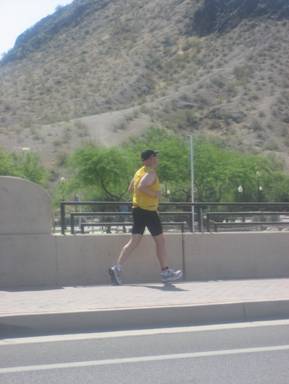
Every aid station, I asked for two waters. By the end I’d have to hold up two fingers because I was trying to use my voice, but no sound was coming out. One station was squirting people with a hose. As refreshing as this sounded, since I still had more running to do, I knew that I was just going to get hotter as a response, so I gestured, no thanks. Another aid station was giving out kitchen sponges dunked in ice water. Again, cool off quick and heat up slow. I skipped the sponges, but if the water wasn’t too cold I’d drink one cup and throw the other one onto my neck and chest to shock myself into continuing to move. I thanked one volunteer who replied, “Thank God you’re running; that way I don’t have to.” I looked back conspiratorially. “I’ll see you out here next year.”
Finally I got to my last segment on the bridge. Everything else started to blur away. My chest was tight, my hips and quads had dull pain but nothing out of the ordinary. I dug my feet in and told myself, one more lap, just a quarter-mile.
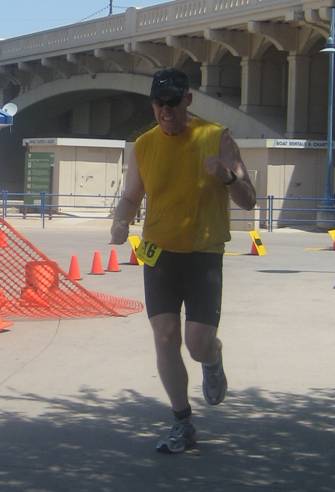
By the time I got to the grass I was gritting my teeth, clenching my fists, anything to keep my body moving forward. I hit the line, jumped as always, pumping my right fist. And another one down! I wandered disoriented for a second or two while volunteers took the chip off of my leg. Another gave me a bottle of ice-cold water. I walked over to the kids, who took stacks of pictures. Lisa finished about 20 minutes later.
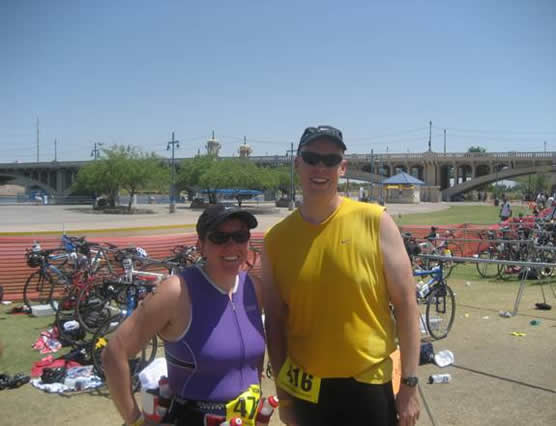
I wasn’t as beaten down as I was after Silverman; I could move, but not quickly. By now it was 100. My finish time was 3:29:56 – officially six minutes slower than last year, but the math gets all messed up when you factor in the longer swim. I had a faster run and a faster bike than the year before, so overall I’d assume I improved a little bit. I’ll continue to do this race – there’s a lot to like about Phoenix – but I’ll continue to wonder how to prepare for these conditions without winding up in an ambulance.
